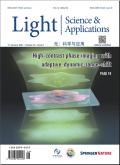Light People | Prof. Wei Lu spoke about infrared physics.
IF 23.4
Q1 OPTICS
引用次数: 0
Abstract
Professor Wei Lu is a leading scientist in infrared physics. He proposed the paradigm of localized manipulation over electrons and photons for infrared detection, addressing the critical challenge of dark current suppression in long-wave infrared detectors. His direct observation of the Haldane gap in quasi-one-dimensional magnetic materials was one of the earliest experimental validations of the Haldane's conjecture - a crucial step in the theoretical discoveries of topological phases of matter that led to 2016 Nobel Prize in Physics for Duncan Haldane. Beyond fundamental research, Prof. Lu and his team developed a series of new advanced infrared detectors on multiple remote sensing satellite platforms. During his tenure as the Director of China's State Key Laboratory of Infrared Physics and President of the Shanghai Institute of Technical Physics (SITP) at the Chinese Academy of Sciences, he led the strategic development of the institutions, contributing to China's breakthroughs in spaceborne remote sensing technologies.吕伟教授讲了红外物理学。
陆伟教授是红外物理学领域的杰出科学家。他提出了用于红外探测的电子和光子的局部操作范式,解决了长波红外探测器中暗电流抑制的关键挑战。他对准一维磁性材料中霍尔丹隙的直接观察是霍尔丹猜想最早的实验验证之一,这是物质拓扑相理论发现的关键一步,邓肯·霍尔丹因此获得2016年诺贝尔物理学奖。除了基础研究,陆教授和他的团队还在多个遥感卫星平台上开发了一系列新的先进红外探测器。在担任中国科学院红外物理国家重点实验室主任和上海技术物理研究所所长期间,他领导了该机构的战略发展,为中国在星载遥感技术方面的突破做出了贡献。
本文章由计算机程序翻译,如有差异,请以英文原文为准。
求助全文
约1分钟内获得全文
求助全文
来源期刊

Light-Science & Applications
数理科学, 物理学I, 光学, 凝聚态物性 II :电子结构、电学、磁学和光学性质, 无机非金属材料, 无机非金属类光电信息与功能材料, 工程与材料, 信息科学, 光学和光电子学, 光学和光电子材料, 非线性光学与量子光学
自引率
0.00%
发文量
803
审稿时长
2.1 months
 求助内容:
求助内容: 应助结果提醒方式:
应助结果提醒方式:


